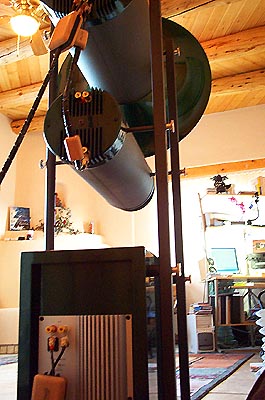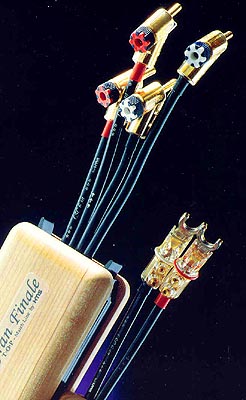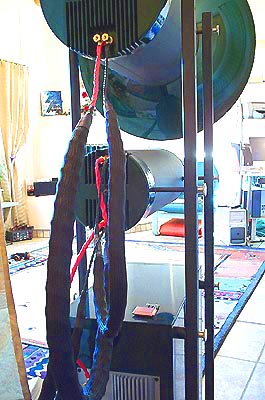 |
||||||||||||||
|
Listening perspective
|
||||||||||||||
| < Consider the Avantgarde DUO's disparate approach for the midrange/treble (horn-loaded = minimum effort) and bass (sealed box, high-current solid-state amp = brute force). You quickly appreciate the intrinsic challenges: To sonically appear as though cut from a single cloth of common character, top to bottom. In my original review, I commented on my perceived discontinuity of gestalt. Easeful gushing of the horns versus super-athletic muscularity of the twin woofers. By judiciously experimenting with subtle adjustments of bass crossover and attenuator, I'd eventually arrived at a very pleasing blend and thought no more of it. Until, that is, my recent visit to Avantgarde importer Jim Smith. In his personal system, he demonstrated a yet more seamless transition and "horn-like" quality in the bass. I attributed that to a more refined front-end and/or a more meticulous setup which minimized room interactions beyond what I had accomplished in my own room. Not. Without repositioning my DUOs or new Afghan Kilim/Shastri chair by even a single sly millimeter, the quality of the bass was potently transformed. Here are two descriptors whose relative opposition of character hints at the rather unusual effects: "Chiseled from bedrock" and "invisible continuousness". The former character of minor "difference" -- between upper and lower bands -- had evaporated to NeverNeverLand. The horn-typical sensation of speed, clarity -- and above all, effortlessness -- now extended all the way into the stygian depths. The bass had become more natural, by turning less obvious. |
||||||||||||||
 |
||||||||||||||
With a minor fuzz or bloat eliminated, bass notes now went silly low. However, they no longer caused those common side effects I had assumed were vestigal remnants of minor room loading. Resonances, in other words. So hold it. If resonances they had been indeed; and a simple cable change could banish them... then they couldn't have been room geometry boundary interactions. They must have been materials resonances. Right? Should I now point at the lacquered ferrite beads of the Gran Finale MkII speaker cable? Do they act as resonance inhibitors? Grasping them in my hands to discern the level of bass pulses you can literally feel propagating through most speaker cable telegraphed affirmation. I could no longer discern the cable's tactile heartbeat, even at raucous levels with mindless drum-machine dancehall tracks. Should I point at mitigated timing issues? Due to the long wavelengths involved, that would reap noticeable dividends in the bass region and produce a greater sense of rhythmic incision. It's certainly what the effects of superior "damping" sounded like. More litheness of character. Greater fleetness of foot. Enhanced intelligibility of foundation subletites, all the while reaching lower with greater clarity. |
||||||||||||||
 |
||||||||||||||
| You sense my reluctance, at citing specific cause-and-effect contributors. Still, these ruminations point at what I heard, regardless of understanding precisely who caused what and how. I'll leave any technical explanations to Herr Strassner. There was an additional fringe benefit to these bass improvements. I could play things louder without raising the dreaded specter of artifical boom. What I usually think of as the settling dust and debris of aural mortar impacts. Needless to say, this caused the proverbial trips to the deep well. What other bass-heavy albums were stashed away in the rarely-played corner that I could test these prodigious new-found qualities with? Plenty of silly indulgences followed. |
||||||||||||||
 |
The second quantifiable element of the HMS effect? Image density to either side off stage center. It now retained its intensity undiluted all the way to the farthest reaches left and right. Have you noticed how most systems -- whose speakers aren't spread too far to thin out center fill -- project their greatest focus in the middle? They throttle back saturation and impact on the stage edges. Once I inserted the Energia powercords to complete the all-HMS setup, this sensation of left-right continuousness became overwhelming. It truly subtracted the speakers - not in a positive sense as though they'd been overt sources of sound by having images stick to them (they never had). In the negative, as though they had formerly caused a spatial absence of reduced focus; one that alerted you subliminally to their presence by acting as slightly blurry areas in an otherwise perfect-focus photograph. This seamlessness of image density became one of the biggest contributors to no-artifice enjoyment. The sense of wholesale immediacy -- now including all performers simultaneously, not just the spotlighted soloists dead- or slightly off-center -- made a profound difference. It removed yet another reminder of playback limitations, a perceptual veil if you will that wasn't a visual but feeling-dimension factor. A third ingredient involved in these improvements concerned the depth dimension. Each time I've progressed at reducing system noise in the past, enhanced detail perception was the result. |
|||||||||||||
I'm thus reasonably certain that Strassner's comprehensive noise reduction techniques -- from the RF filters in the powercords to the Zobel networks in the speaker cable -- had once again lowered the noisefloor in a non-subtle way. But often, added detail equates to sensory overload. It stimulates a growing listener sense of discomfort, tension and eventual fatigue. By contrast, the HMS sound was very natural and relaxed. Detailed yet organic. Unlike the new 4-inch silver ribbon Audio Magic Clairvoyant cables, these skinny cables didn't emphasize musical energy for the kind of added excitement that I hear in most of Jerry Ramsey's products. All the details were there and then some - but they didn't remind you of themselves. Leading edges didn't appear dulled. But neither did they receive that added infusion of zip that for example the Audio Magic Stealth Power Purifier produces. This made muted trumpets, struck strings, close-miked soprano sax, blaring brass in general, great fun. Pull out all those Salsa bigbands whose blistering heat and stridency would usually peel off your wallpaper and banish them inside the dustry drawers. The HMS cable walked the tightrope of sizzle versus warmth by leaning ever-so-slightly on the warm side. This rendered even outright hot recordings palatable, yet didn't produce the kind of body and heft the NBS Black Label's distinct middbass enhancement added. |
||||||||||||||
| On the subject of which, I have a confession to make. To these ears, Walter's finest effort clearly errs on the side of overt body and warmth. My friend Nobuko owns a complete Black Label system. She prefers it distinctly over the equivalent NordOst Valhalla and top-line Siltech efforts. Her reference setup uses Art Audio Jota monoblocks and 7" Hamilton Audio monitors. The added heft and wallop of the NBS snakes transform her potentially bass-limited rig into a full-range powerhouse that excels with the kind of Techno, Club, Rap, Jap-Pop and Chill-Out fare she favors for daily fun listening. If Walter voiced these cables in the context of his system I recently described -- with unique speakers that eschew direct-radiation for 360-degree room-boundary reflections -- I can appreciate the enormous benefits this particular voicing would offer. However. My full-range hornspeakers are in no need of midbass boost or added "meat-on-them-bones". Consquently, the Black Label voicing caused excess weight in this band. Naturally, this impinged on midrange clarity. It also weighted down the perception of transient mobility and rhythmic coherence. To allay these effects, I would have to significantly revoice the DUOs. While certainly possible, this would overlook two facts.
|
||||||||||||||
 |
||||||||||||||
| I'm thus stalwartly resisting the notion. Consequently, I shall return the NBS Black Label cables to its maker without formal review. Acknowledging that a highly experienced listener -- whose listening acumen I trust implicitly -- has such splendid results with it makes the prospect of penning an overtly critical review appear like an unpleasant waste of time. Who would it serve - except those of course who assume that unless you write the occasional "bad" review, you're on somebody's payroll or deaf. At least that's my opinion. Since I'm the one who'd have to write it, I get to insist on the final word in this matter. In closing this subject, I will only add this. Juxtaposing the HMS against the top-shelf NBS, at 1/10th its hideous price and easily 10 times the ease of installation -- but remembering that a card-carrying audiophile preferred the latter over category-leading known contenders -- does indeed reflect very favorably. On the price/performance value that Strassner has built into these Teutonic wires. It certainly behooves any well-heeled music lovers who presently considers entry into these elevated ranks, to put the HMS Gran Finale on his or her list with the back-of-mind promise that one might save a considerable bundle in the bargain. Back to what the Gran Finale accomplished in this, my "Round One" prior to any optimization protocal of adjusting switches and dials. Lower noisefloor. More highly developed depth perception. Absolutely seamless image focus left to right. Bass control that envelops the bottom octaves into tacit continuousness with the remainder of the spectrum. Timing precision that's a function of removing "fuzzy edges" especially in the mid- and lower bass. A sense of added clarity that lacks hype and tension, doesn't inject added excitement and creates a supremely natural, mid-hall relaxation with far superior resolution over what such a placement would create in an actual venue. This latter quality of "relaxed naturalness" indicates an astute balance. While the HMS Gran Finale does not strike me as lean by a long shot, it also doesn't add body like the NBS Black Label. In that respect -- of weight or heft -- I'd call it neutral and precise rather than "voiced" or deliberately contoured for presence. Tonal balance? Just a touch warm, never strident or in-your-face even when indicated by inferior source material. Ability to resolve minute detail? Phenomenal, yet never analytical. Build quality? Second to none. While the ClearAudio RCAs with their clever banana center pin lack the locking sleeves of WBTs, they made tight contact on a variety of jacks. Seeing that Herr Strassner picked WBT loudspeaker terminations, one might assume that the non-locking ClearAudio low-level connectors were chosen for their sonic superiority over the equivalent WBTs. Added bonus? The noise-reduction filters built into the cables make external Zobel networks like Lloyd Walker's excellent High Definition Links redundant (I tried it.) Ditto for power line conditioning. |
||||||||||||||
 |
The sheer scope of across-the-band improvements vis-à-vis my customary Analysis Plus wiring makes this state-of-the-art effort's ticket of admission rather palatable. Just ogling the HMS Gran Finale cables validates the level of craftsmanship and hand labor lavished upon them. That level of workmanship plainly costs money. Outside the readily available -- but expensive -- connectors, there are no off-the-shelf items in sight. This clearly ain't a deceptive "Belden repackage job" of which this sector of the industry is so embarassingly often -- and rightfully -- accused. |
|||||||||||||
|
|
||||||||||||||
| How would it perform in your own system? As always, that's for you to find out. The 30-day satisfaction guarantee offered by the importer certainly makes that easy. The wholesale impact its insertion had on my system, versus my customary Solo Crystal (which Marc MIckelson, in his recent SoundStage! review with appended Reviewer's Choice designation, compared favorably to NordOst Quattro-Fil & SPM) makes me suspect something. Its "performance headroom" is plenty expanded to translate powerfully into other systems even if you were to lose a few percentage points. And remember. The inbuilt adjustability could make the opposite true. They might perform even better for you than they did for me. Now that's a truly scary thought! On this note, I shall bow out for today. While I'm leary as hell to change anything in my system right now, I will -- as a conscientious reviewer -- tear it all apart again to re-insert one cable at a time. I shall then report -- if possible -- what item/s in particular caused the greatest good toward the stunning sound I'm presently grooving to. I feel like some carefree trustfund heir, with zero concerns over standard work hours (don't I wish). Expect said follow-up report in late Feburary after my CES report has gone live. |
||||||||||||||
 |
||||||||||||||
 |
||||||||||||||
|
US distributor's website
|
||||||||||||||
| manufacturer's website | ||||||||||||||
 |
||||||||||||||